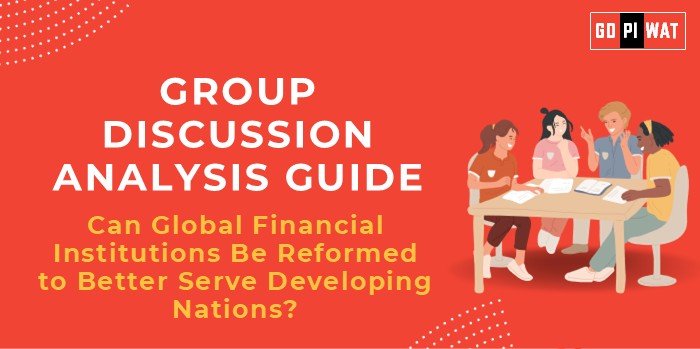📋 Group Discussion Analysis Guide: Can Global Financial Institutions Be Reformed to Better Serve Developing Nations?
🌐 Introduction to the Topic
📖 Opening Context
Global financial institutions (GFIs) like the World Bank and International Monetary Fund (IMF) were established to promote international economic stability and development. However, their effectiveness in addressing the unique challenges of developing nations has been questioned, particularly as global economic dynamics evolve.
📜 Topic Background
Initially established in the aftermath of World War II, GFIs aimed to rebuild war-torn economies and promote global cooperation. Over the decades, their role has expanded to address global poverty, climate change, and economic crises. Despite this, criticisms about disproportionate voting power, conditional lending practices, and policy biases remain at the forefront of debates.
📊 Quick Facts and Key Statistics
- ⚖️ Voting Power Inequality: Advanced economies control 60%+ of IMF voting rights.
- 💰 Lending Volume: IMF approved $48.7 billion in emergency financing for developing nations in 2023.
- 📉 Debt Challenges: Low-income nations’ external debt reached $152 billion in 2023 (World Bank).
- 🌍 Climate Finance Gap: Developing nations need $1 trillion annually by 2030 for climate adaptation and mitigation (UN).
🤝 Stakeholders and Their Roles
- 🏦 Global Financial Institutions: Design and implement policies, provide loans, and offer technical assistance.
- 🌍 Developing Nations: Seek financing for development but face constraints due to structural reforms mandated by GFIs.
- 🌐 Advanced Economies: Influence decision-making through majority voting power in institutions like the IMF.
- 📢 Civil Society and NGOs: Advocate for more inclusive and equitable financial policies.
🏆 Achievements and Challenges
✨ Achievements
- 🌍 Poverty Reduction: GFIs contributed to reducing global poverty by financing infrastructure and social programs.
- 💼 Crisis Management: Swift response during the COVID-19 pandemic, with $650 billion in IMF Special Drawing Rights (SDRs).
- 🌱 Climate Investments: The World Bank committed $32 billion to climate-related projects in 2023.
⚠️ Challenges
- ⚖️ Voting Power Imbalance: Developing nations lack proportional representation, limiting their influence.
- 🛠️ Policy Conditionality: Structural Adjustment Programs often lead to social inequalities.
- 📉 Debt Sustainability: High-interest loans exacerbate the debt burden for low-income countries.
🌍 Global Comparisons
- ✅ China: Established the Asian Infrastructure Investment Bank (AIIB) to address regional development gaps.
- ♻️ Nordic Model: Emphasizes grants and concessional loans for sustainable projects.
📖 Case Study
- 🇮🇳 India: Benefited from World Bank financing for rural electrification but faced criticism for delayed disbursements.
💡 Structured Arguments for Discussion
- 🛠️ Supporting Stance: “Reforming GFIs will empower developing nations to lead sustainable development with equitable resources.”
- 🛡️ Opposing Stance: “Reforms are unlikely without significant shifts in geopolitical priorities of advanced economies.”
- ⚖️ Balanced Perspective: “Reforms require multilateral efforts to balance the interests of both advanced and developing economies.”
🎯 Effective Discussion Approaches
🔑 Opening Approaches
- 📜 Historical Context: “Since their inception, GFIs have shaped global economic policies but have also drawn criticism for perpetuating inequalities.”
- 📊 Statistical Start: “With $152 billion in external debt, developing nations face an urgent need for equitable financial reforms.”
⚙️ Counter-Argument Handling
- 🔄 Acknowledge: Progress in poverty reduction but highlight disparities in policy impact.
- ➡️ Redirect: Use examples like the AIIB to suggest alternative reform models.
🧠 Strategic Analysis of Strengths and Weaknesses
SWOT Analysis:
- 💪 Strengths: Crisis management, technical assistance, global outreach.
- 🛠️ Weaknesses: Representation gap, conditionality issues, limited climate financing.
- 🌟 Opportunities: Expansion of voting rights, climate finance leadership.
- ⚠️ Threats: Emerging alternatives like AIIB, geopolitical conflicts.
🏫 Connecting with B-School Applications
📚 Real-World Applications
- 🌍 Frameworks for financial inclusion and international project management.
🎓 Sample Interview Questions
- ❓ “How can GFIs better address climate finance gaps?”
- ❓ “What role can emerging economies play in reforming GFIs?”
💡 Insights for B-School Students
- 📈 Understand the intersection of finance, policy, and sustainable development for internships or research projects.


